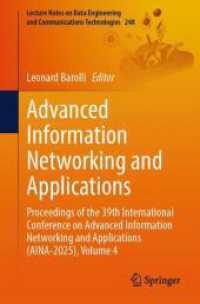Full Description
This book provides a practical, step-by-step approach to designing and implementing evaluation projects targeting a variety of DEI goals in academic library collections.
Offering both flexibility and detailed guidance, Assessing Academic Library Collections for Diversity, Equity, and Inclusion begins with a discussion of aspects of diversity that librarians could target in their assessment projects and notes project planning considerations such as defining a scope and timeline. It particularly notes how larger academic libraries can narrow the scope of a project to make it feasible. Subsequent chapters explain different methods for assessing a collection, with many examples throughout.
Methods include:
- List-checking involves comparing the collection to a list of recommended books.
- Metadata searching produces a count of library holdings that contain certain subject headings or use specific call numbers.
- Diversity coding allows staff to create their own categories and assign them to books in a sample.
All three of these methods can be used to analyze the collection by subject matter. It is possible to use diversity coding to examine author identities as well, a sensitive endeavor for which this book provides both cautions and guidance. A fourth approach focuses on organizational efforts or inputs. This method involves tracking and reflecting on the library's progress towards goals the staff have set, which could involve a variety of collections-related activities, including staff development, changes to workflows, revising policies, or increasing outreach. The book describes advantages and limitations of the four methods, allowing librarians to make an informed choice of which to use. It also offers resources for implementing each of these strategies as well as guidance on creating one's own evaluation tools. Three chapters by guest authors provide examples of DEI assessment projects from academic libraries. A concluding chapter discusses sharing findings and suggests a range of changes libraries can make to their collecting practices.
Contents
Acknowledgements
List of Figures
List of Tables
List of Text Boxes
Chapter 1: Assessing Collections for Diversity, Equity, and Inclusion
Chapter 2: Defining Diversity
Chapter 3: Choosing an Approach
Chapter 4: Project Planning
Chapter 5: List-Checking
Chapter 6: Two Types of List-Checking at the University of West Florida, by Melissa Gonzalez
Chapter 7: Metadata Searching
Chapter 8: Diversity Coding
Chapter 9: Coding New Acquisitions for Diversity of Subject Matter and Authorship at Emory & Henry University, by Artemis D. Vex and Ruth Castillo
Chapter 10: Assessing Institutional Efforts
Chapter 11: Assessing DEIJA Projects at Ithaca College Library, by Karin Wikoff
Chapter 12: Moving Forward
References
Index
About the Authors








